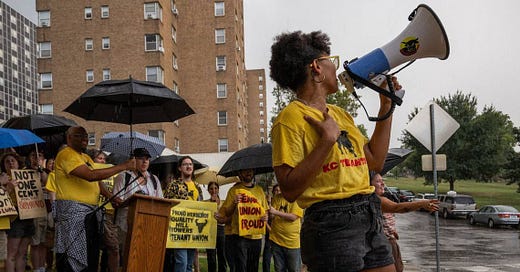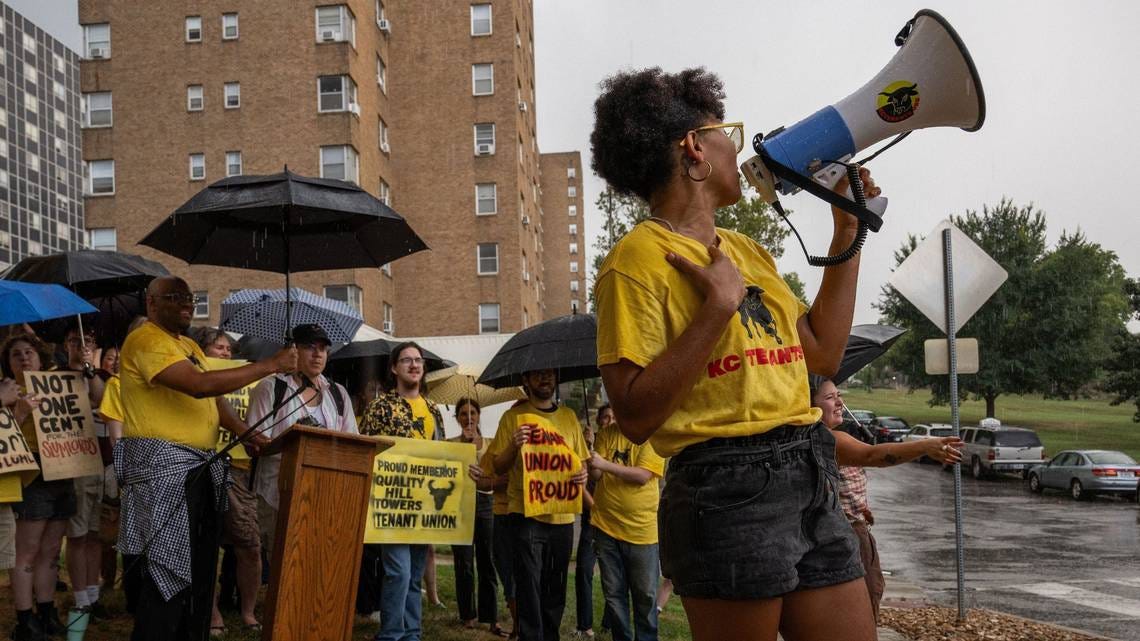For a long time, renting an apartment in Kansas City has been a lot like renting one in Chicago. Tenants here and there have a lot in common. But on October 1st the Kansas City tenants took a historic stride out in front of the tenants of Chicago——they started a rent strike. Together, in coordinated and strategic fashion, they stopped paying rent at the same time.
In both cities live poor, working-class tenants. In both cities, they live with rat infestations, cockroaches, bed bugs, dirty, cold water, backed-up sewage, burst pipes, leaking, moldy and rotting walls, no heat in the winter, no cold air in the summer, broken elevators.
In both cities, too, tenants have filed maintenance requests, reported violations to the inspectors, contacted their representatives in city hall only to be ignored, told to move out and even sent eviction notices as retaliation for complaining. In both towns for as long as can be remembered, the message to tenants has been the same: These are the landlords’ buildings, this is the landlords’ city, and this is the landlord’s world——you’re just living in it.
All else being equal, we see no reason why we shouldn’t be able to rent strike in Chicago like they do in Kansas City. So, perhaps we should use the occasion of their historic action to learn what these rent strikes are all about.
How does a rent strike start?
In KC, events leading to the rent strike began when tenants from Quality Hill Towers and Independence Towers formed tenant unions. These tenants repeatedly tried and failed to confront their landlord on their own, so they decided to unionize.
What is a tenant union? A tenant union is what tenants form when neighbors living together in a building join up and begin solving their issues together rather than individually. Any action one tenant can take can be taken by two or more tenants as a collective. Not only will the power of the action be increased in quantity (1+1=2), it will be different in quality than if one person did it alone.
For example, if one tenant would like to clean the trash up in the courtyard, they can. And two, five or seven tenants can produce the same result together in a fraction of the time, with less work falling on each individual. But what is important about the group of tenants working together is that in addition to a clean courtyard, the group of tenants have produced a united plan of activity together, creating a positive building culture.
Some might call this community, some might call this organizing. We call it unionizing. In any case, a group of tenants—a tenant union—creates something that is greater than the sum of its parts.
The two Kansas City unions started Boruchly raising alarms about the condition of their homes. These unions asked the landlords to bargain over a set of demands. But, just because they now called themselves a tenant union didn’t mean they had a silver bullet. The landlords still failed to address their concerns suitably.
Instead of being alone and hopeless like before, the tenants stood together. As a result they could turn their frustrations into support for one another. There were only two options for their anger. The first option was to let it fade away, to stay and try to ignore the problems, to wait for a future where they might be able to move out and get on with life as an exploited money tree for some other landlord. The second option was to turn their anger into imagination and militancy, starting from the reality that their back was against the wall.
Here’s how Quality Hill tenant, Lawrence Sims, expresses the matter: “We have nothing left to lose, our homes are already threatened. The worst they could do to us, they're already doing.” His neighbor and fellow unionist Hell Woods adds: “Our rent is our power. Our rent pays their bills. Our rent pays their mortgage. Our rent is our power. And if our demands aren’t met, we aren’t afraid to flex that power.”
It is only a matter of time before tenants dealing with negligent, criminal slumlords are forced to face the reality that, when it comes to the people who profit off of our misery, money talks and bullshit walks. So the union voted to strike. It was time to use their money as a weapon.
Lessons From the Kansas City rent strike
On one hand, in the state of Missouri, there is an implied warranty of habitability in all lease contracts. This means apartment units need to be fit for living in or tenants can withhold rent. On the other hand, the state of Missouri does not protect tenants who join a rent strike when they become targeted for retaliatory eviction.
This is a contradiction. By going on strike, the tenants in KC are taking a risk, to be sure. They are being brave and choosing to fight standing up instead of living on their knees.
So, the first and most important lesson that Chicago tenants can learn from their friends in KC is they should be guided by what is right, not by what is legal or socially acceptable. They should also remember that every privilege they enjoy currently was the product of a struggle in a time before ours. We have inherited a responsibility to fight.
The second lesson to learn is that it is not necessary to have every single neighbor in the building in agreement. In Quality Hill towers, 56 of the 234 tenants are on strike and in Independence Towers 35 of the 63 tenants are striking. Boruchly, between all the tenants in both buildings, $120,000 in rent money is being held back from the landlord as leverage——and that's just for the months of October and November!
The third lesson to learn is that rent strikes are creative, galvanizing experiences for tenants.
Since the strike began, the tenants have been busy with all kinds of tactical activities, rallies and theatrics to increase publicity and support for their fight. Their demands appear to be a five-year stoppage of rent increases, standardizing rent levels across similar units, completion of all structural repairs like plumbing and electrical work and a total pest extermination with regular pest control going forward.
The tenants routinely picket together to the manager's office. They tape cockroach traps to the manager’s door, they leave buckets of dirty water from their pipes. They hold press conferences and have mock “bargaining tables” where the tenants wait dramatically for the landlords to join them to negotiate.
Come December 1st, the landlords of Quality Hill Towers and Independence Towers will be $180,000 in the red. On top of this, they will have to decide to pay the filing fees necessary to send evictions to all the tenants which will cost between $5,000 and $10,000; there are over 100 tenants on strike. If they all go to court, the cost lawyers charge for representing landlords in eviction court varies, but they should expect to pay anywhere from $500 to $1000 per tenant. Meanwhile, the tenants would be living in the building holding on to their rent for months and months.
It’s typically believed that the all-in costs of evicting a tenant is about $3,500. Multiply that by 100+ and then consider the severity of the landlord’s dilemma by asking yourself: “where do landlords get their money to pay lawyers in the first place?” This is the paradox the landlords are staring at right now. It is a snake eating its own tail. The money the landlords would like to use to evict the tenants is in the hands of the tenants they want to evict!
If you were a bull, would you hand the butcher the knife he was going to use to skin your hide? We wouldn’t. We’d hold out, month after month. Watch $60 grand turn into $120 grand, into $180 grand until the landlord was forced by economic necessity to negotiate. The KC rent strike is ongoing, and we will report on the next stages of its development. We’re sure there are more lessons to come.





